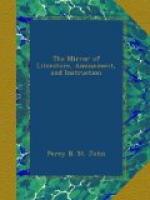The exterior architecture of the chapel is almost destitute of ornament; if we except the reeded windows, and the double buttresses at the angles of the tower, which is stated to be short of its original height. On the east side, two angular lines mark the connexion which the chapel had with the other buildings, and a part of the ground plan may be traced by an adjoining wall, in which are the remains of two circular arches, comparatively little impaired. Mr. Rhodes observes “a wreath of ivy which falls from the top of the tower, and nearly invests one side of it, breaks the dull monotony of its outline, and produces a tolerably good effect: in other respects it is not strikingly attractive as a picturesque object. The Abbey of Bello-Capite will ever be dear to the antiquary who will visit it with veneration and delight; nor will the artist pass it by unnoticed. The magnificent woods, and the beautiful hills that environ the Abbey of Beauchief, amply compensate for any deficiency of grandeur in the subordinate adornments of so rich a scene.”
Beauchief Abbey, though once a considerable structure, was never proportionally wealthy. At the time of its dissolution, (Henry VIII.) the whole of its revenues were estimated but at 157_l_; and with the materials furnished by its demolition was built Beauchief House upon the same estate, granted by Henry VIII. to Sir William Shelly. The mansion is still tenanted.
Crosses.
These emblematic relics stand in two of the villages in the Peak district: viz. Eyam and Wheston. They are places of little importance; though a touching interest is attached to Eyam, from it having been visited by the Great Plague of the year 1666; its population, at this time, was about 330; of whom 259 fell by the plague.[2] The history of this calamitous visitation forms the subject of a meritorious poem by W. and M. Howitt, entitled the Desolation of Eyam, in which the piety of Mr. Mompesson, (who then held the living of Eyam,) his pastoral consolations to his mourning people, and the amiable character of his beautiful wife, who fell a victim to the plague,—are narrated with true pathos. Yet, this afflicting episode in village history—
So sad, so tender and so true.
having been but recently related by our ingenious contemporary, Mr. Hone,[3] we quote but two of the opening stanzas by the Messrs. Howitt:
Among the verdant mountains of the Peak
There lies a quiet hamlet,
where the slope
Of pleasant uplands wards the north-wind’s
bleak;
Below wild dells romantic
pathways ope;
Around, above it, spreads
a shadowy cope
Of forest trees: flower, foliage,
and clear rill
Wave from the cliffs, or down
ravines elope;
It seems a place charmed from the power
of ill
By sainted words of old: so lovely,
lone, and still.




